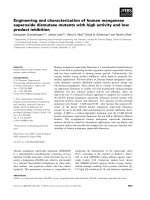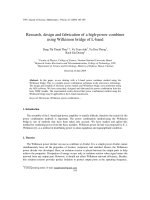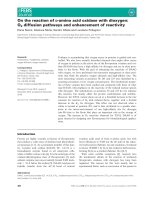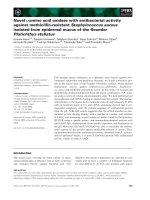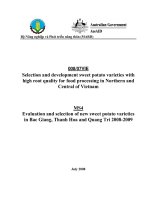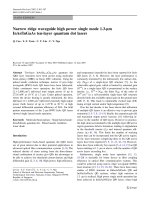Lightweight lead acid battery with high power
Bạn đang xem bản rút gọn của tài liệu. Xem và tải ngay bản đầy đủ của tài liệu tại đây (317.98 KB, 11 trang )
SAE TECHNICAL
PAPER SERIES
2004-01-3208
Lightweight Lead Acid Battery with High Power
Ramesh Bhardwaj, Chhaya Bhardwaj and John Timmons
Concorde Battery Corporation
Sue Waggoner
NSWC
Bill Johnson
Naval Air System Command
Power Systems Conference
Reno, Nevada
November 2-4, 2004
400 Commonwealth Drive, Warrendale, PA 15096-0001 U.S.A. Tel: (724) 776-4841 Fax: (724) 776-5760 Web: www.sae.org
All rights reserved. No part of this publication may be reproduced, stored in a retrieval system, or
transmitted, in any form or by any means, electronic, mechanical, photocopying, recording, or otherwise,
without the prior written permission of SAE.
For permission and licensing requests contact:
SAE Permissions
400 Commonwealth Drive
Warrendale, PA 15096-0001-USA
Email:
Fax:
724-772-4891
Tel:
724-772-4028
For multiple print copies contact:
SAE Customer Service
Tel:
877-606-7323 (inside USA and Canada)
Tel:
724-776-4970 (outside USA)
Fax:
724-776-1615
Email:
ISSN 0148-7191
Copyright © 2004 SAE International
Positions and opinions advanced in this paper are those of the author(s) and not necessarily those of SAE.
The author is solely responsible for the content of the paper. A process is available by which discussions
will be printed with the paper if it is published in SAE Transactions.
Persons wishing to submit papers to be considered for presentation or publication by SAE should send the
manuscript or a 300 word abstract of a proposed manuscript to: Secretary, Engineering Meetings Board, SAE.
Printed in USA
2004-01-3208
Lightweight Lead Acid Battery with High Power
Ramesh Bhardwaj, Chhaya Bhardwaj and John Timmons
Concorde Battery Corporation
Sue Waggoner
NSWC
Bill Johnson
Naval Air System Command
Copyright © 2004 SAE International
1.0 Abstract:
The aircraft industry demands high
power batteries for auxiliary power unit
(APU) and engine start. The power
demands for these applications are met
lead acid battery, however, these
batteries are bulky and heavy. One of the
important criteria for selecting an
aircraft battery is its weight. There is an
acute need for a lead acid battery, which
can supply the power and energy
demands of the application but also be
lightweight. In this paper we present the
use of lead coated Aluminum (Al) grids
which result in a lightweight lead acid
battery. The battery with lead (Pb)
coated Al grids are 15% lighter in
weight when compared to conventional
lead acid battery. The results on
capacity, high rate and cycle life of
batteries made from lead coated Al grids
is presented and discussed in detail in
this paper.
2.0 Introduction:
The aircraft industry demands high
power and high-energy batteries for
various applications such as auxiliary
power unit (APU) start, direct engine
start, computer backup and emergency
DC power for avionic or emergency
lighting. Conventional lead acid batteries
are capable of providing the demanded
performance at temperatures as cold as
–40°C, but they are bulky and heavy.
The high power demands are met by
increasing the opposed surface area of
the electrodes by incorporating more
plates per cell in a battery.
This
increases the weight of the battery. The
cast or expanded lead (Pb) grids used as
the current collector have manufacturing
limitations in terms of thickness, weight,
high resistivity and current carrying
capability. The idea of using low weight
thin grids was initiated at Concorde
Battery Corporation in the year 2000
when the possibility of using lead plated
Aluminum (Al) grids was successfully
implemented to make a lightweight lead
acid battery [1-5]. The30Ah/24V
batteries with Pb plated Al grids have
exceeded the high power capability and
cycle life required of typical military
aircraft batteries. The batteries with Pb
plated Al grids have shown weight
savings of 10-15% when compared to
the conventional lead acid battery. This
paper presents the use of Pb plated Al
grids in a lead acid battery for aircraft
application. The results on capacity,
cycle life and high rate testing are
presented and discussed in detail. The
weight savings on 5Ah to 30Ah, 24 V
batteries are presented and compared
with conventional lead acid batteries.
3.0 Experimental:
Aluminum grids were punched from
0.025-0.038 cm thick Al 5052 alloy
sheets. They were cleaned, degreased,
deoxidized and etched using Oakite and
acid etch solutions. Lead cannot be
plated on aluminum alloy directly due to
its poor adherence. Concorde battery has
developed a two-step proprietary
activation process, which takes 30
seconds, where thin layer of metal
covers the Al before Pb can be plated on
the aluminum grid. This activation layer
allows good coverage on Al against
corrosion and provides adherence of Pb
on the Al grids. Electroplating of lead
was carried out using conventional lead
plating bath. Plating was carried out at
different current densities of 5 to 50
A/ft2. A smooth, pinhole free and
uniform Pb plating was obtained
between current density of 15A-30
A/ft2.
into 30 Ah/24 V batteries. Two types of
batteries were assembled. One group of
batteries used lead plated Al grids in the
negative electrode and the second groupcontained batteries with lead plated Al
grids in the positive electrode. The
batteries were tested for their capacity to
20 V at discharge current of 30A.
Immediately after capacity test, batteries
were conditioned as per military
specification and tested for high rate at
constant voltage of 14 V. The current at
14 V was monitored every 0.1 Second
for 60 seconds. The high rate test was
conducted at room temperature as well
as at –26 C. The life cycle tests were
conducted at 30A discharge for 1 hour
and constant voltage charge at 28.8V for
2 hrs.
Two types of plating solutions were used
for lead plating on he surface of
activated Al grids. The first type of
plating solution was lead fluoborate
made in fluoboric acid, which provided
excellent lead covering but was
environmentally unfriendly. We also
performed lead plating to study the
environmentally
friendly
second
solution, which contained methane
sulfonic acid. The results indicated that
the second solution was not only
environmentally friendly but also
provided more pinhole free, uniform and
robust covering of lead on the surface of
activated Aluminum grid.
Four 30A/24V batteries were assembled.
Two batteries contained lead plated Al
grids in the negative electrode with the
positive being the conventional lead grid
electrode. Two batteries were assembled
using positive Al grids and negative
being the conventional lead grid
electrodes. The assembly involved
stacking positive plates with glass mat
separator with negative plates on both
sides of positive plate. A special fixture
for cast-on-connection was designed to
connect all negative and positive plates
to make a single cell. A lead-tin alloy
was used for the cast-on-connection to
use the differential melting temperature
between the plated lead and cast-on
connection lead. The melting point of
the Pb-Sn alloy is 610°F while the
melting point of the electroplated lead on
Al is around 620° F. This temperature
difference allowed us to make the cast-
The Pb plated Al grids were washed
with water and pasted with a
conventional positive and negative
active material (PAM and NAM). The
pasted plates were cured and assembled
4.0 Results and Discussion:
4.1 Battery assembly:
on connection without melting the
electroplated lead from the Al grid.
Twelve cells were connected in series to
make 30A/24 V batteries. All batteries
were filled with sulfuric acid of correct
concentration and formed at low current
for extended period of time. The extra
acid is removed after conditioning cycles
and battery is capped with a pressure
relief valve vent valve. Batteries after
formation
are
provided
with
conditioning cycles for acid gravity
adjustment.
4.2 Battery testing:
The batteries are tested for their capacity
and compared with conventional grid
batteries.
4.2.1 Capacity Test: The capacity test is
performed at 30A discharge until 18 V
and recharged at 28.8 V for 2 hrs. We
found that Aluminum grid battery and
conventional
lead
grid
batteries
delivered exactly the same capacity of
40-42 Ah at tested rate and Aluminum
grid batteries shows no improvement or
degradation in the capacity performance.
4.2.2 High Rate Test:
The batteries are charged completely
after the capacity test and tested for high
rate at a constant 14V discharge for 60
seconds and current is monitored every
0.1 seconds. The results of high rate test
at room temperature are shown in
Figure1. Note that both batteries met the
military specification but Al grid
batteries in negative electrode delivered
slightly better current compared to
conventional battery. The better results
can be attributed to higher conductivity
of Al base material compared to the lead
grid.
Both batteries with Al grids
provided similar data indicating that Al
grid batteries are equal or better than the
conventional lead grid batteries. The
batteries were charged completely after
room temperature high rate test and kept
in the freezer for 24 hours at –26 C. The
batteries were taken out after 24 hrs and
immediately tested for high rate
performance. The high rate performance
of control battery and battery with Al
negative grid is shown in Figure 2. The
batteries with Al negative electrode met
the
all-military
specification
requirements and were better than
conventional battery especially after 45
seconds. Conventional battery missed
two specification points at –26 C while
Al grid battery current was higher than
specification at all recorded times.
1200
Specification (RT)
Al Grid at RT
Pb Battery (B) (RT)
Current (Amp)
1000
800
600
400
200
0
0
10
20
30
40
50
60
70
TIME (SECONDS)
Figure 1 High rate 14V test at room temperature
800
Specification (-26C)
Al Grid (-26C)
Pb Battery (A) (-26 C)
Current (Amp)
700
600
500
400
300
200
100
0
0
10
20
30
40
Time (seconds)
50
60
70
Figure 2 High Rate tests at -26 C
4.3 Life Cycle Test: The life cycle test
was performed as per military
specification. The batteries were
discharged at 30A for one hour followed
by constant voltage charge at 28.8 V for
2 hours. The cycle life of first battery
with Pb plated Al grids in negative
electrode are shown in Figure 3.
4.3.1 Battery with Al Negative Grid:
The first battery was cycled till it
completed 85 cycles. The fully charged
battery was removed from cycle tester
and left at room temperature for voltage
decay measurement for two months. The
voltage decay of the battery as a function
of time is shown in Figure 4. The battery
shows loss of 1 Volt in about 160 days,
which is 0.62 mV per day. The voltage
decay curve indicates that there was no
unusual loss of voltage in a battery with
lead coated Al grids. The battery was
charged back after 160 days and tested
for capacity. The battery recovered all
capacity and delivered 65 additional
cycles before it reached to 80% of its
initial capacity. Figure 5 shows the cycle
data after voltage decay measurements.
Charge/Discharge
Capacity (Ah)
40
30
20
Charge
Discharge
10
0
0
20
40
60
80
100
Cycle Number
Figure 3 Cycle life of battery with Pb coated Al negative electrode
30
Voltage (V)
25
20
15
10
5
0
0
50
100
Number of Days
Figure 4. Voltage decay of battery after 85 cycles
150
200
Charge/Discharge Capacity (Ah)
45
40
35
30
25
20
15
10
5
0
Charge Cap
Discharge Cap
0
10
20
30
40
50
60
70
Cycle Number
Charge/Discharge Capacity (Ah)
Figure 5 Cycle life of battery after voltage decay measurements
45
40
35
30
25
20
15
10
5
0
0
20
40
60
80
100
120
Cycle Number
Figure 6 Cycle life of second battery with Pb coated Al negative electrode
The second battery with lead coated Al
grid was cycled till it reached 80% of its
capacity. Figure 6 shows the plot of
charge-discharge capacity as a function
of cycle number. The battery delivered
112 cycles before it started receiving
Charge/Discharge Capacity (Ah)
greater charge. Battery was removed
once the charge acceptance increased at
about 110 cycles. It is important to note
that voltage decay of battery with Al
grids and all Pb grids after 85 cycles was
similar indicating that Pb plated Al grids
did not get exposed to sulfuric acid even
after 85 cycles. The cycle life data
before and after voltage decay
measurements clearly indicates that Pb
plated Al grids can be used in a lead acid
batteries in a negative electrode
providing the advantage of substantial
weight savings for aircraft as well as for
other applications where weight saving
is important.
4.3.2 Battery with Al Positive
electrode:
Two 30Ah/24V batteries with Al
positive electrode were assembled. First
battery contained positive electrode of
lead coated Al grids, which were plated
by lead in fluoborate solution. The Al
grids for the second battery were plated
with lead in methane sulfonic acid
solution. The cycle life of first battery
with Al positive electrode is shown in
Figure 7.
70
60
50
40
30
20
10
0
0
20
40
60
80
100
120
Cycle Number
Figure 7 Cycle life of battery with Pb coated Al positive electrode
Note that the battery started receiving
more charge after few cycles and
continue accepting increased amount of
charge compared to discharge. Although
battery did not fail to deliver required
amount of energy (30A for 1 hr) till 110
cycles but charge acceptance was
abnormally high. The greater charge
acceptance can be attributed to exposure
of Al grid underneath the lead. It is
stated that lead plated parts in a
fluoborate solution might contain
microscopic pinholes not visible to the
naked eye. Dipping the lead coated parts
in boiling peanut oil can seal the
pinholes. Although we were aware of the
technique, but decided to use the lead
plated Al grids without sealing. It was
decided that these microscopic holes
might be responsible for higher charge
currents.
Charge/Discharge Capacity
(Ah)
The second battery was assembled using
Al grids plated with lead in a sulfonic
acid solution. Figure 8 shows the cycle
life of battery. The battery delivered 112
cycles. The battery was removed after
112 cycles for other tests. The discharge
capacity increased from 30-40 cycles,
which is normal in new lead acid battery
but it, remained fairly constant until 100
cycles. The charge increased after about
100 cycles but much less compared to
that observed in first battery with Al
positive grids. The improved results
indicated that the methane sulfonic acid
produces better Pb plating compared to
fluoborate solution and does not require
extra step of sealing the pinholes. The
implementation of Al grids in batteries
can result in weight savings as shown in
Table 1. The minimum and maximum
savings indicates either electrode is
replaced or both electrodes are replaced
with Pb coated Al grids.
40
30
20
10
0
0
20
40
60
80
100
120
Cycle Number
Figure 8 Cycle life of second battery with Pb coated Al positive electrode
Table 1. Comparison of battery weights with conventional Pb grid and Pb coated Al grids
Battery Type
Weight Pb Grid Weight
Savings Weight of Al grid
Battery
Battery
with
(lb)
Al Grids
Min (lb) Max (lb) Min (lb) Max (lb)
D8565/5-1
80
4.0
11.0
69.0
76.0
D8565/4-1
26
2.3
4.0
22.0
23.7
D8565/7-2
64
4.5
10.0
54.0
59.5
D8565/15-1
90
5.0
13.4
76.6
85.0
RG-18
19
2.0
3.7
16.3
17.0
RG-206
36
4.0
8.0
28.0
32.0
5. 0 Conclusions:
The work clearly demonstrates that Pb
plated Al grid can be used successfully
in lead acid batteries delivering 100-120
deep discharge cycles and are capable of
reducing the weight of current aircraft
batteries by 10-15 %. The high rate
data shows that Al grid in negative
electrode improves the high rate
performance at room temperature as well
as at –26°C. The improvement is more
noticeable at –26°C. The batteries with
Al grids in both positive and negative
electrode are being assembled and tested
and results will be published in the
future.
Acknowledgement: Authors would like
to thank Steven Fagan, Bill Johnson,
Susan Waggoner, Allen Goodman, and
NAWC for continuing support and
financial assistance for this research
under contract # N68335-03-C-0063.
References:
1. Bhardwaj R. C., Timmons J. B.,
and Orsino J.A., US patent #
6,566,010, May 20, 2003.
2. Timmons J. B., Bhardwaj R.C.
and Orsino J.A., US patent #
6,316,148, Nov 13, 2001.
3. Timmons J. B., and Orsino J.A.,
Bhardwaj R.C., US patent #
6,447,954, Sept. 10, 2002.
4. Bhardwaj R. C., Timmons J. B.,
and Orsino J.A., US patent
#6,586,136.


